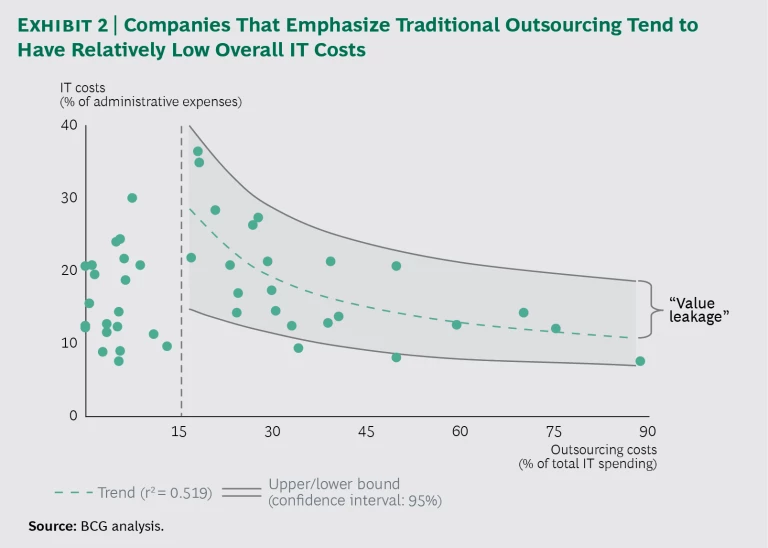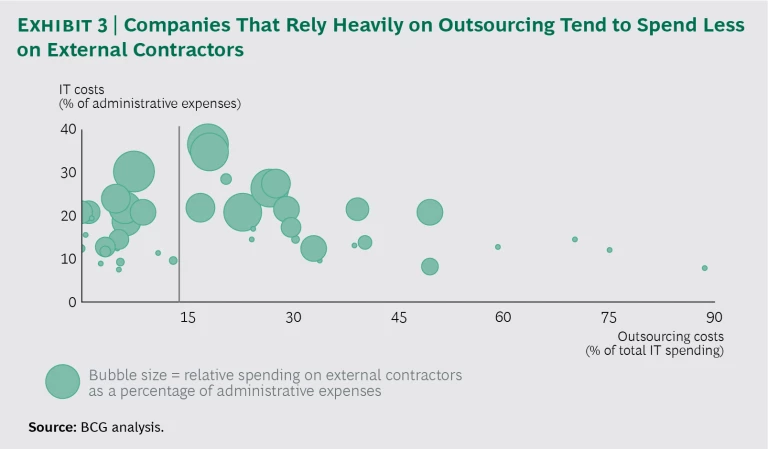Cost saving is a critical objective for most companies that use outside help for the management of their IT function. Many businesses, though, fail to realize the savings they expected. And such failures are common whether the companies use traditional outsourcing (in which IT services are shifted wholly or in part to one or more provider organizations whose compensation is based on the satisfaction of mutually agreed upon service levels), external contractors (individuals who are paid a daily or hourly rate), or both.
What explains this “value leakage”? The reasons vary, ranging from poor contracting practices to inadequate oversight of vendors. But the bottom line is that many companies are not getting what they hoped for—and they have largely themselves to blame.
In 2016, we engaged in extensive studies of companies across industries, with a particular focus on banks, to determine what works and what doesn’t in the management of IT outsourcing programs.
Challenges in the Use of Outside Support
Most companies that use external support employ a combination of contractors and traditional outsourcing. Companies engage external contractors when it is more expedient or advantageous to bring in certain capabilities from the outside than to build them internally. Companies also turn to external contractors when they have short-term, project-based needs, when they need to add capacity quickly, or when they need to add capacity without adding full-time head count.
Companies deploy traditional outsourcing for a number of reasons: to gain access to state-of-the-art technology or competencies, to realize labor cost advantages in application development, to achieve greater flexibility, and to take advantage of large providers’ economies of scale.
Both the use of external contractors and the deployment of outsourcing can bring sizable advantages. But each path presents challenges as well.
External Contractors. Running an IT function without external contractors would be difficult. These individuals bring many benefits, including new skills and methodologies, to the table and can improve the flexibility of the IT department as a whole. But they can also escalate IT costs. Indeed, we find a strong correlation between overall IT costs and money spent on external contractors. This is not to say that there aren’t exceptions—that is, companies with relatively high spending on external contractors and relatively low IT costs. But we observe that, typically, the more a company spends on external contractors, the higher its IT costs are likely to be. (See Exhibit 1.)
This correlation stems from several factors. One is contractors’ instinct for self-preservation and the highest possible compensation. These individuals are paid a daily or hourly rate; the more they work, the more they get paid. So they have a vested interest in staying with the company as long as they can. (Compounding the cost effects on the company, a lengthy tenure often translates into a higher rate for the contractor.) Some external contractors will try to maximize their tenure and hours by making themselves indispensable—for example, by creating a monopoly on specific knowledge or skills.
Spending on external contractors can also climb beyond expectations when companies turn to contractors as a stopgap measure. Many companies will hire an external contractor to fill in temporarily for an internal worker who has left the company, for example—but the move often becomes a long-term situation owing to a hiring freeze or some other reason, or simply out of convenience.
Many companies also turn to relatively high-cost external contractors to execute big IT transformation projects, rather than outsourcing the transformation or managing it themselves. Finally, some companies whose outsourcing providers are falling short will turn to external contractors to close the gap. The net effect in such situations is that the company uses external contractors much more extensively than it had planned, pushing up its IT costs proportionately. (Extensive use of external contractors can also entail legal risks; some countries have laws prohibiting the prolonged use of externals as a substitute for full-time hiring.)
Outsourcing. The success of an outsourcing program, like the successful use of external contractors, hinges largely on how it is executed and on the underlying strategy. Our analysis reveals that many companies struggle with execution and strategy and, as a result, fail to lower IT costs through outsourcing. These failures occur regardless of which parts of IT the companies target with outsourcing—change-the-business activities, run-the-business activities, or a single technology stack.
Our studies confirm that there is indeed potential for lowering IT costs through outsourcing. But the size of the savings, and the related demands on execution, vary according to companies’ orientation toward, and relative emphasis on, outsourcing. (Companies with sufficiently large IT spending might be able to realize scale effects that are greater than the cost advantages afforded by outsourcing providers. But among the companies we studied, none had IT spending of that magnitude.)
We divide the companies we studied into two groups: those for which traditional outsourcing represents a relatively small portion (less than 15%) of total IT spending, and those for which outsourcing represents a more substantial portion (more than 15%).
Companies in the first group tend to put relatively little emphasis, if any, on optimizing the management of their outsourcing program. This tendency, coupled with the limited use of outsourcing, means that the total cost savings available through outsourcing for this group are typically low. Simultaneously, many of the companies in this group make relatively significant use of external contractors, which drives up their total IT costs. (There are exceptions: some companies that place little emphasis on outsourcing also make only limited use of external contractors—and have very low overall IT costs. These companies’ low cost profile stems mostly from their small size or the relatively high degree of specialization in their business, which allows them to get by with simpler IT solutions. These companies may also have extremely high administrative costs, so the benefits of their low IT costs might be overstated.)
In contrast, companies for which traditional IT outsourcing is a relatively large part of their total IT spending tend to have relatively low overall IT costs. (See Exhibit 2.) Our experience indicates that this tendency is due mostly to these companies’ emphasis on optimizing the execution of their outsourcing program. These companies develop sophisticated vendor management organizations, for example, that can manage deals and negotiate complex contracts.
These companies also rigidly control their use of external contractors. (See Exhibit 3.) And the maturity of their management capabilities tends to rise as their reliance on outsourcing grows. Finally, these companies tend to develop a sound sourcing strategy and thereby reduce the complexity of their IT landscape. The combination of these efforts translates into greater cost savings.
For such companies, greater reliance on outsourcing tends to deliver proportionately higher benefits. Companies for which outsourcing represents 15% to 40% of total IT spending tend to see their IT costs fall as their outsourcing rises. There are several reasons for this correlation. Working within this range, it is relatively easy for a company to manage its outsourcing program. It is also relatively easy for the outsourcing provider to deliver on the cost advantages that come from its greater scale and efficiency relative to the client, especially because the activities being outsourced (for example, end-user computing) are typically quite basic. (We note, however, that, although the general correlation with lower overall IT costs is clear, there can be considerable variability in the cost performance of companies whose emphasis on outsourcing falls within this range. Those with the best performance, in general, exercise strong management of their outsourcing partners and show relatively low reliance on external contractors. Companies with lagging performance often have not determined how best to go about outsourcing and apply a half-baked approach to outsourcing management.)
Management of programs of this size can entail challenges, however. Companies can lose their grip on requirements management, for example, and face rising numbers of requests for customized products and services as a result. Such demand from users undermines the cost savings that are possible through outsourcing, which relies on standardization. Companies often wrestle with the challenges of managing a large number of suppliers. Many companies try to handle this through the use of complex contract structures. But they ultimately find that these contracts themselves are difficult to manage.
In spite of the pitfalls of large outsourcing programs, the companies among those we studied that had the lowest overall IT costs outsourced heavily. One company we studied that had a particularly favorable cost profile outsourced fully 90% of its IT.
How Can Companies Do Better?
We have seen companies push their IT costs significantly higher through poor decisions related to outsourcing, the use of external contractors, and the mix of the two. One company, for example, turned increasingly to external contractors to meet internal demand for services; the number of external firms the company used grew significantly, and the number of external workers on site grew to represent 50% of the company’s IT workforce. This pushed the firm’s IT costs through the roof.
It doesn’t have to be that way. From our study of companies that are relatively skilled practitioners in this realm, we have identified actions that can help ensure that the use of external help delivers to its full potential. These actions range from the design of a strategic plan to specific measures that optimize implementation.
Outsourcing Combined with External Contractors. We have observed that the companies that are most successful in managing a mix of traditional outsourcing and external contractors do the following:
- Ensure that the sourcing strategy aligns with the overall IT and business strategies. Successful companies recognize that, as a general rule, heavy reliance on external contractors translates into relatively high IT costs.
- Ensure that there are clear policies for make-versus-buy decisions, an effective vendor sourcing strategy for the management of strategic partners and niche and transactional providers, and clear rules on when and where to engage external contractors. Addressing these considerations reduces the potential for vendor lock-in and establishes the flexibility to cope with evolving technology requirements and changing demand for IT services.
- Develop the governance capabilities needed to execute the sourcing strategy. This requires a properly staffed retained organization with the ability to choose the right vendors, determine the optimal number of vendors, define an appropriate model for interactions with vendors, and establish the processes, KPIs, and contracts necessary to foster vendors’ delivery of low-cost, high-quality services.
- Reduce complexity in the IT landscape, either unilaterally or working with the provider or providers, by replacing, modernizing, or outsourcing legacy assets and streamlining IT processes. Harmonizing systems through the use of standardized commercial software packages, introducing cloud-based computing tools, and decommissioning legacy systems can help reduce complexity. We have found that when reducing complexity with the support of outsourcing suppliers, the institution of metrics as part of the sourcing-governance effort can significantly improve the quality of providers’ application development. (See “Why Measurement Matters in Outsourced Application Development.”)
WHY MEASUREMENT MATTERS IN OUTSOURCED APPLICATION DEVELOPMENT
Bill Curtis, the executive director of the Consortium for IT Software Quality, is best known for leading the development of the Capability Maturity Model. BCG’s Heiner Himmelreich recently spoke with Curtis about the critical role of measurement in the management of outsourced application development. Below is an edited excerpt of the discussion.
What is the state of software measurement in outsourced application development?
The quality of measures has gotten better, but the quality of their use has gotten better only in disciplined organizations. Disciplined organizations know that you can’t manage outsourced application development effectively without numbers. Successful improvement techniques like lean and Six Sigma rest on process and product measurement. Strong measurement is a hallmark of strong management.
What about agile development?
Many so-called agile projects are not performing agile methods rigorously. They use the agile label as an excuse to shortcut practices, especially measurement. However, I have visited disciplined agile organizations whose walls were covered with burn down charts, test progress displays, and other measures of effectiveness.
Are there areas where disciplined organizations could improve?
Product measurement has been weak for decades. Testing assesses mostly the functional aspects of applications, leaving the nonfunctional, structural quality poorly assessed. Without analyzing the source code, especially at the architectural, system level, organizations cannot predict their operational risk or the cost of corrective maintenance. Too often, cost exposures are not discovered until application maintenance is outsourced. Case studies at Allianz, Credit Suisse, AT&T, and other organizations have reported reductions in defects, operational incidents, and corrective maintenance costs of 50% or more when structural quality measures were used to enforce improvement targets. Companies should insist that their suppliers use these measures.
Are there standards for structural quality measures?
The Consortium for IT Software Quality developed standards that were adopted by the Object Management Group [an international technology standards consortium] for measuring reliability, security, performance efficiency, and maintainability in source code. These measures identify violations of good architectural and coding practice that are so severe they must be eliminated.
How should these measures be used in managing outsourcers?
CISQ measures should be included in contracts for establishing acceptance thresholds and for determining award fees. Acceptance targets, such as no more than one reliability weakness per 100 function points, can be set for each measure. These measures should also be used for specifying weaknesses, such as SQL injection, that must not appear in the code.
Any final thoughts?
In an era of nine-digit defects [failures whose related damages exceed €100,000,000], executives must establish policies that include structural quality measures, and they must hold their organizations accountable for using those measures to improve applications.
- Continuously monitor the mix of in-house employees, external contractors, and outsourcing suppliers, and ensure that the vendor management team has the capabilities to ensure service continuity and maintain cost-effectiveness. The successful companies continually invest in the management capabilities of their retained IT orrganizations.
- In structuring contracts with outsourcing suppliers, focus on outcomes and delivered value rather than on input-based parameters, such as the number of full-time employees to be devoted to an account. In application sourcing, outcomes can be measured in terms of structural and architectural attributes of the software, which have an impact on incidents, risk, and the future adaptability of a software-driven business.
External Contractors. To optimize their use of external contractors, the best companies employ these practices:
- Limit the number of external contractors (both self-employed contractors and those secured through agencies) that the company can employ—by utilizing preferred partner programs, for example.
- Hire external contractors only to work on topics in which the company lacks expertise and does not plan to develop the required capabilities internally. This practice demands the development of a strategic workforce plan and a disciplined IT strategy.
- Set strict timeframes on how long an external contractor can remain under contract and how long the company must wait before hiring the same contractor again.
- For companies that spend big on external contractors but use outsourcing only sparingly, consider increasing outsourcing to reduce the need for external contractors.
Outsourcing. To get the most from their outsourcing efforts, the successful companies do the following:
- Strive to limit the number of vendors. Institute a supplier ecosystem that extends beyond traditional IT providers to include such companies as fintechs and digital players.
- Continually monitor the mix of in-house employees, external contractors, and outsourcing suppliers, and ensure that vendor management has the capabilities to ensure service continuity and cost-effectiveness.
- Frequently assess vendors’ price competitiveness through benchmarking, cost trend analysis, and measurement of the performance and productivity of services to identify areas where IT costs could be reduced.
- Renegotiate contracts with vendors every 24 to 36 months, and insert clauses in contracts that commit vendors to continuous performance improvement and/or cost reductions.
- Continually invest in the management capabilities of the retained IT organization.
- Insist that suppliers use the company’s service management tools and methodologies to ensure a “single source of truth” and to enable seamless functioning between the company and its suppliers.
- Ensure that suppliers implement technology upgrades in accordance with the company’s architectural guidelines and security and compliance requirements. This will also facilitate the smooth, cost-effective engagement of new suppliers.
- Ensure that suppliers comply with the company’s service delivery requirements—meeting KPIs, developing proper documentation and reports, and following defined processes, for example.
- Measure the structural and architectural quality of vendor software deliverables to protect the business from stability, performance, and security threats and to minimize the risk of vendor lock-in.
For many companies, outsourcing, including the use of external contractors, fails to lower IT costs. But an outsourcing program of the right scale, coupled with skillful execution and the right underlying strategy, can deliver material reductions in costs and, ultimately, bring competitive advantage.








